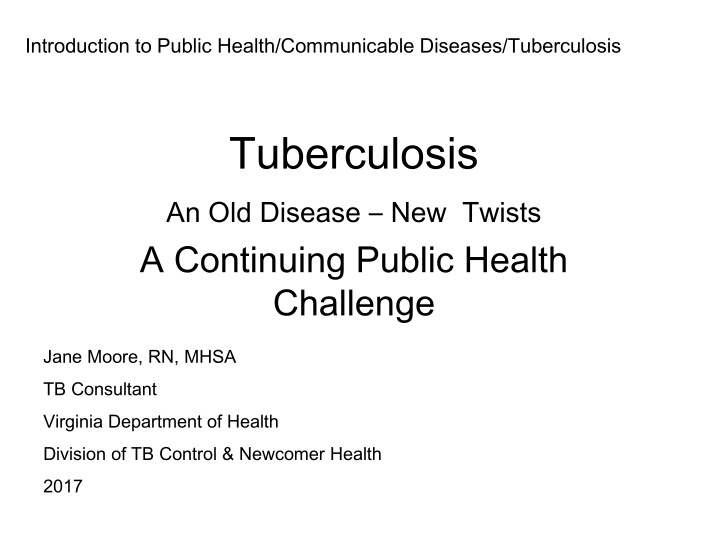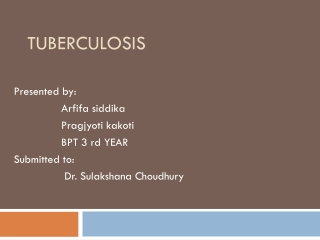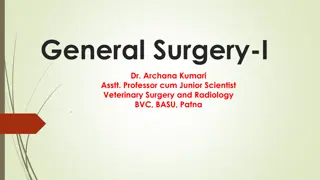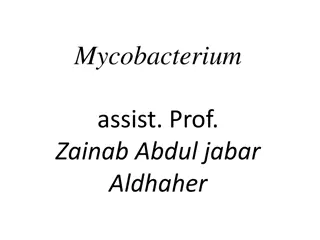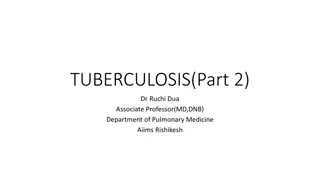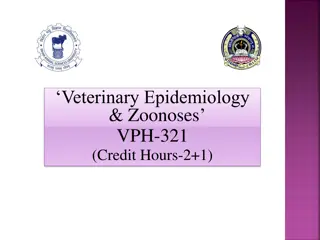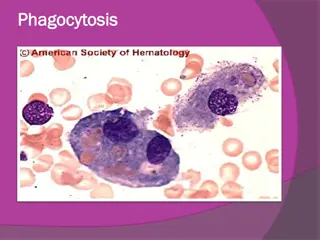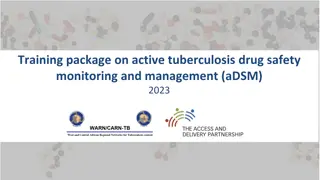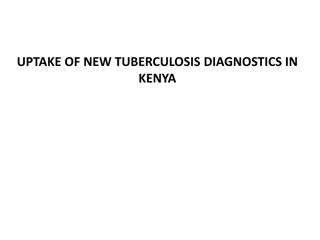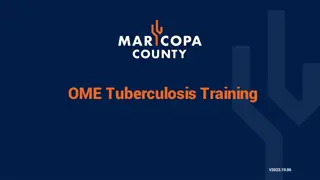Evolution of Tuberculosis: From Ancient Origins to Modern Challenges
Tuberculosis, an ancient disease possibly acquired from domesticated animals thousands of years ago, has transitioned from endemic to epidemic in human populations. The causative agent, M. tuberculosis, was identified by Robert Koch in 1882. Over the years, public health efforts, improved nutrition, and medical advancements have contributed to a decline in TB rates, though challenges like drug resistance and global spread persist.
Download Presentation

Please find below an Image/Link to download the presentation.
The content on the website is provided AS IS for your information and personal use only. It may not be sold, licensed, or shared on other websites without obtaining consent from the author.If you encounter any issues during the download, it is possible that the publisher has removed the file from their server.
You are allowed to download the files provided on this website for personal or commercial use, subject to the condition that they are used lawfully. All files are the property of their respective owners.
The content on the website is provided AS IS for your information and personal use only. It may not be sold, licensed, or shared on other websites without obtaining consent from the author.
E N D
Presentation Transcript
Introduction to Public Health/Communicable Diseases/Tuberculosis Tuberculosis An Old Disease New Twists A Continuing Public Health Challenge Jane Moore, RN, MHSA TB Consultant Virginia Department of Health Division of TB Control & Newcomer Health 2017
Tuberculosis Old Disease May have evolved from M bovis; acquired by humans from domesticated animals ~15,000 years ago Endemic in humans when stable networks of 200-440 people established (villages) ~ 10,000 years ago; Epidemic in Europe after 1600 (cities) 354-322 BC - Aristotle When one comes near consumptives one does contract their disease The reason is that the breath is bad and heavy In approaching the consumptive, one breathes this pernicious air. One takes the disease because in this air there is something disease producing.
Tuberculosis 1882 Robert Koch one seventh of all human beings die of tuberculosis and if one considers only the productive middle-age groups, tuberculosis carries away one-third and often more of these
M tuberculosis as causative agent for tuberculosis Robert Koch 1886
TB in the US 1882-2016 1900-1940 TB rates decreased in the US and Western Europe before TB drugs available Better nutrition, less crowded housing Public health efforts Earlier diagnosis Limit transmission to close contacts TB sanatoria Surgery
TB in the US 1882-2016 1940s-1960s TB specific antimicrobial agents Single drugs use produced resistance Multiple drugs 1960s-1980s TB considered a non-problem TB treatment moved to private sector Loss of TB-specific public health infrastructure
TB in the US 1882-2016 1990s TB re-emerges as a threat TB-HIV co-infection Drug-resistant TB Globalization allows TB to travel 1990s Increased support for TB prevention and control Funding for public health efforts (case management, contact investigation, directly observed therapy Better diagnostic and patient management tools 2016 Lowest number of reported cases in US
TB in the United States: 2016 9,546 new cases reported in 2016 Lowest incidence rate of 2.9/100,000 US born rate declined 8.4% to 1.1/100,000 Foreign born rate declined 3.2% to 14.6/100,000
TB in the US Continuing challenges Reliable access to TB drugs Emerged as major issue during late 2012 and 2013 Regulatory requirements limit access to international supplies Loss of expertise Clinical Laboratory Program Concentration of remaining cases in difficult to reach populations Need to address large pool of persons with TB infection
TB Invades/Infects the Lung Effective immune response Infection limited to small area of lung Immune response insufficient
Natural History of TB Infection Exposure to TB No infection (70-90%) Infection (10-30%) Latent TB (90%) Active TB (10%) Never develop Active disease Untreated Treated Die within 2 years Survive Die Cured
Latent TB vs. Active TB Latent TB (LTBI) (Goal = prevent future active disease) = TB Infection = No Disease = NOT SICK = NOT INFECTIOUS Active TB (Goal = treat to cure, prevent transmission) = TB Infection which has progressed to TB Disease = SICK (usually) = INFECTIOUS if PULMONARY (usually) = NOT INFECTIOUS if not PULMONARY (usually)
Treatment Most TB is curable, but Four or more drugs required for the simplest regimen 6-9 or more months of treatment required Person must be isolated until non-infectious Directly observed therapy to assure adherence/completion recommended Side effects and toxicity common May prolong treatment May prolong infectiousness Other medical and psychosocial conditions complicate therapy TB may be more severe Drug-drug interactions common
TB Case Rate per 100,000 VA and US: 2012-2016 Year Virginia TB Cases Virginia TB Rate US TB Cases US TB Rate 2012 235 2.9 9,951 3.2 2013 179 2.2 9,582 3.0 2014 198 2.4 9,412 3.0 2015 212 2.5 9,563 3.0 2016 205 2.4 9,546 2.9
TB continues as a public health issue in the United States Old public health concepts (isolation of infectious individuals, closely monitored treatment, recognition and preventive treatment for infected contacts,) are still critical, but will not eradicate TB Care providers not familiar with signs/symptoms of TB Diagnosis delayed Inappropriate treatment Drug resistance due to improper use of drugs Must address both US born and newcomer populations Older, remote exposure Incarcerated, homeless, history of drug , alcohol use Newcomers from high TB prevalence areas
Challenges to Public Health System Public health workers must: Educate, coordinate care with private sector Identify support services (food, housing) Treat TB in geriatric populations Treat TB in children Deal with alcohol, drug abusing, incarcerated and/or homeless patients Manage TB in patients with underlying medical conditions Provide culturally appropriate care for non-English speaking/non-literate populations Treat TB cases with drug- resistant TB
VA TB Cases by Region: 2007-2016 200 180 160 2007 2008 2009 2010 2011 2012 2013 2014 2015 2016 Number of Cases 140 120 100 80 60 40 20 0 Northwest Southwest Central Eastern Northern
VA TB Cases by Race/Ethnicity: 2007-2016 140 120 Number of Cases 100 Asian/PI 80 Black 60 Hispanic 40 White 20 0 2007 2008 2009 2010 2011 2012 2013 2014 2015 2016 Year
VA TB Cases by Age Group: 2007- 2016 140 120 Number of Cases 100 0-14 80 15-24 60 25-44 40 45-64 20 >64 0 2007 2008 2009 2010 2011 2012 2013 2014 2015 2016 Year
VA Foreign vs. US Born TB Cases: 2007-2016 350 300 Number of Cases 250 200 Foreign Born 150 US Born 100 50 0 2007 2008 2009 2010 2011 2012 2013 2014 2015 2016 Year
VA Foreign Born TB Cases by Years in the US at Start Treatment: 2007- 2016 250 200 Number of Cases 150 >10 years 6 to 10 years 100 3 to 5 years 50 <=2 years 0 2007 2008 2009 2010 2011 2012 2013 2014 2015 2016 Year
VA TB Cases Top Five Countries of Origin: 2007- 2016 2007 2008 2009 2010 2011 2012 2013 2014 2015 2016 Philippines India Ethiopia Ethiopia India India Ethiopia India Philippines India El SalvadorViet Nam Viet Nam Viet Nam Ethiopia Mexico India Viet Nam India Philippines India Philippines India India Philippines Philippines Viet Nam S. Korea Ethiopia Ethiopia South Korea Bolivia Ethiopia Philippines Philippines Viet Nam Philippines Ethiopia Korea Viet Nam El Salvador & Philippines Peru South Korea Mex,China Nepal Mexico Mexico Nepal Viet Nam El Salvador El Salvador
Addressing the Challenges TB Control in the US Current TB Control efforts will not achieve the US goal of < 1 case per million persons Continued surveillance and active prevention measures needed Need to address latent TB infection Reportable? Challenges of long treatment How to reach the foreign born populations Predicting who with TB infection will develop active disease
Addressing the Challenges TB Control in the US Local, state and federal programs have separate but closely related activities Guidelines, Laws and Regulations Guidelines treatment, contact investigation, prevention data driven/expert opinion some are a decade old Laws local or state case reporting, isolation of infectious individuals Regulations - local or state implement laws Federal laws/regulations travel restrictions, entry into the US no interstate restrictions International travel regulations WHO limited
Elements of a Tuberculosis Control Program X-ray Targeted testing/ LTBI treatment Inpatient care Clinical Services HIV testing and counseling Pharmacy Medical evaluation and follow-up Non-TB medical services Social services Laboratory Interpreter/ translator services Patient education Data collection Coordination of medical care DOT Epidemiology and Surveillance Contact investigation Case Management Home evaluation Provider Education & Training Outbreak Investigation Data analysis Housing Data for national surveillance report Follow-up/treatment of contacts Isolation, detention QA, QI for case management Program evaluation & planning Consultation & technical assistance Federal TB Control Program Training State TB Control Program Guidelines Information for public State statutes, regulations, policies, guidelines Funding National surveillance Technical assistance Funding
VA Laws and Regulations VA statute and implementing regulations TB (suspected and confirmed) reportable HCP and laboratory responsible for reporting Treatment plan signed by HD required prior to hospital discharge Antimicrobial sensitivity testing required M.tb isolate must be submitted to state laboratory HD can require patient to appear for examination, counseling Limited ability to require treatment Detention order possible if failure to cooperate puts others at risk http://www/vdh.virginia.gov/tb
Laws and regulations vs. Guidelines Guidelines Not laws Current PHS TB guidelines Evidence based Extensively reviewed by experts Intended to guide, not dictate Often become standard of care Exceptions may be justified, should be documented http://www.vdh.virginia.gov/tb http://www.cdc.gov/tb
VDH TB Prevention and Control Policies and Procedures Based on USPHS/CDC, ATS, IDSA and Pediatric Red Book guidelines Adapted to address uniquely Virginia issues
Thank you Questions? Jane Moore Jane.moore@vdh.virginia.gov
